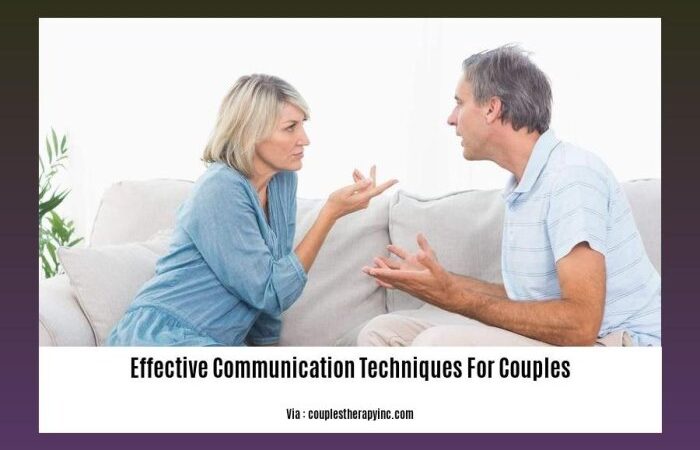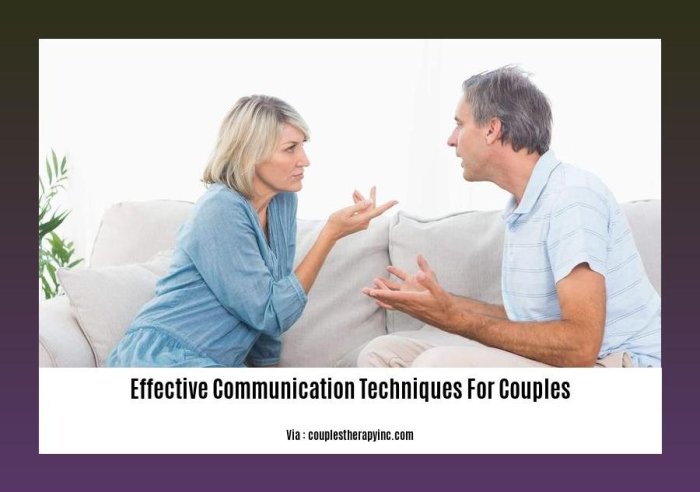Communication Techniques for Couples: Building Stronger Relationships

Communication techniques for couples are essential for building a strong and lasting relationship. Effective communication allows partners to understand each other’s needs, resolve conflicts constructively, and foster intimacy. By learning and implementing these techniques, couples can navigate the ups and downs of life together, deepening their connection and strengthening their bond.
This guide explores a range of communication strategies, from active listening and non-verbal communication to expressing needs and setting boundaries. It delves into the importance of conflict resolution, trust-building, and maintaining open dialogue. Whether you’re a newlywed couple or a seasoned partner, these techniques can enhance your communication and improve your overall relationship.
Active Listening
Active listening is a crucial communication skill in any relationship, but it’s especially important for couples. When you actively listen to your partner, you show them that you care about what they have to say and that you’re truly invested in understanding their perspective.
This can create a strong foundation of trust and intimacy.
Techniques for Active Listening
Active listening involves more than just hearing the words your partner is saying. It requires you to engage with their message on a deeper level, demonstrating that you’re paying attention and trying to understand their thoughts and feelings. Here are some effective techniques:
- Paraphrasing: Restating what your partner has said in your own words can help clarify their message and ensure you’re understanding it correctly. For example, you might say, “So, it sounds like you’re feeling frustrated because…”
- Reflecting Feelings: Acknowledge and validate your partner’s emotions by reflecting them to them. You might say, “It seems like you’re feeling really hurt right now.” This shows empathy and helps your partner feel heard and understood.
- Asking Clarifying Questions: If you’re unsure about something your partner said, don’t hesitate to ask for clarification. This can help prevent misunderstandings and ensure that you’re on the same page. For example, you might ask, “Can you tell me more about what happened?”
Benefits of Active Listening
Active listening can significantly improve communication and strengthen your relationship.
- Enhanced Understanding: Active listening helps you gain a deeper understanding of your partner’s perspective, even if you don’t agree with it. This can lead to more productive conversations and fewer misunderstandings.
- Increased Empathy: When you actively listen, you put yourself in your partner’s shoes and try to see things from their point of view. This can foster empathy and strengthen your emotional connection.
- Stronger Bonds: Active listening shows your partner that you value their thoughts and feelings. This can make them feel loved, respected, and appreciated, strengthening the bond between you.
Non-Verbal Communication
Non-verbal communication plays a crucial role in relationships, often conveying more than words alone. It encompasses a wide range of cues that can either enhance or hinder communication, influencing the overall message and its interpretation. Understanding these cues is essential for building stronger and more effective relationships.
Types of Non-Verbal Communication
Non-verbal communication encompasses a wide range of cues, including body language, tone of voice, and facial expressions. These cues can be subtle or overt, conscious or unconscious, and often provide valuable insights into a person’s true feelings and intentions.
- Body Language: This includes gestures, posture, eye contact, and proximity. For instance, crossed arms can signal defensiveness, while leaning in can indicate interest and engagement. Maintaining eye contact demonstrates attentiveness while avoiding it can suggest disinterest or dishonesty.
- The tone of Voice: The way we speak can convey a range of emotions, even if the words themselves are neutral. For example, a sarcastic tone can undermine a positive message, while a warm and reassuring tone can enhance a comforting message.
- Facial Expressions: Facial expressions are powerful communicators of emotions, with smiles conveying happiness, frowns indicating sadness, and furrowed brows suggesting confusion or concern.
Impact of Non-Verbal Communication on Relationships
Non-verbal cues can significantly impact the dynamics of relationships, both positively and negatively.
- Enhancing Communication: When verbal and non-verbal communication align, it strengthens the message and fosters trust and understanding. For instance, a warm smile accompanied by a sincere compliment can make the message more impactful and create a positive connection.
- Hinder Communication: Mismatches between verbal and non-verbal communication can lead to misunderstandings and conflict. For example, saying “I’m fine” while exhibiting a sad facial expression can create confusion and raise doubts about the sincerity of the message.
Aligning Verbal and Non-Verbal Communication
Effective communication involves aligning verbal and non-verbal cues to ensure consistency and clarity. This means being mindful of the messages conveyed through body language, tone of voice, and facial expressions, and ensuring they align with the spoken words.
“Non-verbal communication is the language of the heart, while verbal communication is the language of the mind.”
Unknown
Conflict Resolution

Conflict is a natural part of any relationship, and it’s important to learn how to resolve disagreements constructively. Healthy conflict resolution involves open communication, empathy, and a willingness to find common ground.
Strategies for Resolving Conflicts
Effective conflict resolution involves understanding the root cause of the disagreement, communicating needs and feelings clearly, and working together to find a solution that meets both partners’ needs. Here are some strategies that can help couples navigate disagreements constructively:
- Choose the Right Time and Place: Avoid bringing up sensitive topics when either partner is tired, stressed, or distracted. Find a time and place where you can both focus on the conversation without interruptions.
- Focus on the Problem, Not the Person: When expressing your feelings, focus on the specific issue at hand, rather than attacking your partner’s character or personality. Use “I” statements to express your needs and feelings without blaming your partner.
- Active Listening: Pay attention to your partner’s perspective and try to understand their point of view, even if you don’t agree with it. Use verbal and non-verbal cues to show that you are listening and trying to understand. Ask clarifying questions to ensure you are grasping their perspective.
- Compromise and Collaboration: Be willing to compromise and find solutions that meet both of your needs. Focus on finding a win-win solution, rather than trying to win the argument.
- Take Breaks When Needed: If the conversation becomes heated, take a break to calm down and collect your thoughts. Agree on a time to revisit the conversation when you are both feeling more calm and rational.
Communication Techniques for Conflict Resolution
Communication is the cornerstone of effective conflict resolution. Here are some techniques that can help couples navigate disagreements constructively:
- “I” Statements: Using “I” statements allows you to express your feelings and needs without blaming your partner. For example, instead of saying, “You always make me feel unimportant,” you could say, “I feel unimportant when I don’t feel heard.”
- Validation: Acknowledging and validating your partner’s feelings, even if you don’t agree with them, can help de-escalate the situation. For example, you could say, “I understand that you’re feeling frustrated about this,” even if you don’t agree with the source of their frustration.
- Empathy: Try to see the situation from your partner’s perspective and understand their feelings. This doesn’t mean you have to agree with them, but it can help you connect with them on a deeper level.
- Non-Verbal Communication: Pay attention to your partner’s non-verbal cues, such as body language and tone of voice. These cues can provide valuable insights into their emotions and how they are feeling about the situation.
Step-by-Step Guide for Conflict Resolution
Here is a step-by-step guide that couples can follow when resolving conflict:
- Identify the Issue: Clearly define the specific issue that is causing the conflict. What is the disagreement about? What are the specific needs and concerns of each partner?
- Active Listening: Each partner should actively listen to the other’s perspective and try to understand their point of view. Use verbal and non-verbal cues to show that you are listening and trying to understand.
- Express Needs and Feelings: Use “I” statements to express your own needs and feelings about the issue. Avoid blaming or attacking your partner. Focus on expressing your perspective without judgment.
- Brainstorm Solutions: Work together to brainstorm possible solutions to the problem. Focus on finding solutions that meet both of your needs, even if they involve compromise.
- Negotiate and Compromise: Be willing to negotiate and compromise to reach a solution that works for both partners. Focus on finding a win-win solution, rather than trying to win the argument.
- Agree on a Plan: Once you have reached a solution, agree on a plan for moving forward. This plan should include specific actions that each partner will take to address the issue.
- Follow-up: Check in with each other periodically to see how the plan is working. Be open to adjusting the plan as needed.
Expressing Needs and Wants

In any relationship, clear and assertive communication of needs and wants is crucial for building a strong foundation of understanding and connection. When couples can openly and honestly share their desires and expectations, it fosters a sense of intimacy and promotes mutual respect.
Using “I” Statements
“I” statements are a powerful tool for expressing feelings and needs without blaming or attacking your partner. They allow you to take ownership of your emotions and communicate them in a way that is less likely to provoke defensiveness.
“Instead of saying, ‘You never listen to me,’ try, ‘I feel unheard when I try to share my thoughts with you.'”
Here are some examples of how to rephrase accusatory statements into “I” statements:
- Instead of: “You always forget to take out the trash.” Try: “I feel frustrated when the trash isn’t taken out, and I would appreciate it if we could work together to keep the house tidy.”
- Instead of: “You never spend any time with me.” Try: “I feel lonely when we don’t spend quality time together. I would love to plan a date night or do something fun together.”
- Instead of: “You’re always on your phone.” Try: “I feel disconnected when you’re constantly on your phone. I would appreciate it if we could put our phones away and spend some quality time together.”
Practicing Effective Communication
To effectively address unmet needs and desires, couples can practice these communication techniques:
- Schedule Regular Check-Ins: Dedicate specific time to discuss each other’s needs and wants, ensuring that both partners feel heard and understood.
- Active Listening: Practice active listening by focusing on what your partner is saying, asking clarifying questions, and reflecting back their feelings.
- Empathy and Validation: Try to understand your partner’s perspective, even if you don’t agree with it. Validate their feelings by acknowledging their experience.
- Compromise and Negotiation: Find solutions that meet both partners’ needs, even if it requires compromise.
- Be Willing to Forgive: Everyone makes mistakes. Be willing to forgive your partner and move forward from misunderstandings.
Building Trust and Intimacy
Trust and intimacy are the cornerstones of a healthy and fulfilling relationship. They are not simply feelings; they are cultivated through consistent effort, open communication, and a shared commitment to understanding and supporting each other. Effective communication plays a crucial role in fostering these essential elements, creating a foundation of emotional connection and security.
The Role of Communication in Building Trust and Intimacy
Communication acts as a bridge, connecting two individuals on a deeper level. It allows partners to share their thoughts, feelings, fears, and hopes, fostering a sense of vulnerability and connection. By engaging in open and honest dialogue, couples can gain a deeper understanding of each other’s perspectives, values, and needs, leading to a stronger emotional bond.
Vulnerability and Sharing Feelings
Vulnerability is the act of revealing one’s true self, including fears, insecurities, and emotions. It requires courage and trust, but it also strengthens the connection between partners. Sharing feelings openly and honestly allows for a deeper understanding of each other’s emotional landscape, fostering empathy and compassion.
“Vulnerability is not weakness, it’s our greatest measure of courage.”
Brené Brown
- Active Listening: Paying full attention to your partner’s words, both verbal and non-verbal, demonstrates that you care and value their perspective.
- Empathy: Trying to understand and share your partner’s emotions, even if you don’t agree with their perspective, shows that you are present and supportive.
- Sharing Personal Stories: Revealing personal experiences and vulnerabilities can create a sense of connection and understanding, building trust and intimacy.
Expressing Appreciation and Gratitude
Expressing appreciation for your partner’s efforts, qualities, and contributions strengthens the bond between you. It reinforces the positive aspects of the relationship, fostering a sense of gratitude and love.
- Verbal Affirmations: Expressing your love, appreciation, and admiration verbally reinforces the positive aspects of the relationship.
- Acts of Service: Doing something thoughtful for your partner, like cooking their favorite meal or running errands, demonstrates care and consideration.
- Gifts: Giving gifts that are meaningful and reflect your partner’s interests or personality shows that you pay attention and care about them.
Activities and Conversations for Building Trust and Intimacy
Engaging in activities and conversations that encourage open communication, shared experiences, and vulnerability can further strengthen the bond between partners.
- Date Nights: Regular date nights provide opportunities to reconnect, share experiences, and create new memories.
- Deep Conversations: Discussing values, dreams, fears, and life goals can create a deeper understanding and connection.
- Shared Hobbies: Engaging in activities you both enjoy creates shared experiences and opportunities for bonding.
- Couple’s Therapy: Seeking professional guidance can provide tools and strategies for improving communication and strengthening the relationship.
Setting Boundaries
Healthy boundaries are essential for any relationship, including romantic partnerships. They help couples define their individual needs, values, and limits, fostering mutual respect, trust, and a sense of autonomy within the relationship. Setting clear boundaries allows each partner to maintain their individuality while nurturing a strong and fulfilling connection.
Communicating Boundaries Effectively
Communicating boundaries effectively involves expressing your needs and expectations clearly, respectfully, and assertively. It’s crucial to choose the right time and place for the conversation, ensuring both partners are calm and receptive.
- Use “I” statements: Focus on your feelings and needs, avoiding accusatory language. For example, instead of saying “You always forget to do the dishes,” try “I feel frustrated when the dishes aren’t done, and it would be helpful if we could share the responsibility.”
- Be specific: Clearly define what you need and what you are comfortable with. Instead of saying “I need more space,” specify what that means, like “I need an hour to myself each evening to read before we talk.”
- Be assertive: Express your needs confidently and respectfully, without apologizing or backing down. For example, “I understand you have a busy schedule, but I need to have a date night once a week.”
- Listen actively: Pay attention to your partner’s perspective and try to understand their needs and feelings. This fosters empathy and helps build a more collaborative approach to boundary setting.
Navigating Boundary Conflicts
Boundary conflicts can arise when one partner’s needs or desires clash with the other’s. Effective communication and compromise are crucial in navigating these situations.
- Stay calm and respectful: Avoid getting defensive or attacking your partner. Focus on understanding their perspective and finding a solution that works for both of you.
- Negotiate and compromise: Be willing to adjust your expectations and find a middle ground that respects both partners’ needs. For example, if one partner needs more alone time, you could negotiate a specific time each day for quiet time.
- Seek professional help: If you’re struggling to navigate boundary conflicts on your own, consider seeking professional guidance from a therapist or counselor. They can provide tools and strategies for effective communication and conflict resolution.
Maintaining Open Communication
Open communication is the cornerstone of any healthy relationship, especially in the long term. It fosters understanding, strengthens emotional bonds, and helps couples navigate challenges together. Maintaining open communication requires consistent effort and a willingness to create a safe and supportive environment where both partners feel heard, respected, and valued.
Regular Check-Ins
Regular check-ins provide a structured opportunity for couples to connect and discuss their thoughts, feelings, and experiences. These check-ins can be brief, informal conversations or more formal, scheduled meetings. The key is to establish a consistent rhythm that works for both partners.
- Frequency: Check-ins can be daily, weekly, or even monthly, depending on the couple’s needs and preferences. It’s important to find a cadence that allows for regular communication without feeling overwhelming.
- Structure: Having a simple structure can help keep check-ins focused and productive. For example, couples can use a specific time each day to discuss their day or use a set of prompts to guide their conversations.
- Focus: Check-ins should focus on listening, understanding, and expressing appreciation. Avoid using this time for criticism or problem-solving.
Scheduled Couple Time
Setting aside dedicated time for each other can help couples prioritize their relationship and create space for meaningful connection. This time can be used for a variety of activities, such as going on dates, engaging in shared hobbies, or simply relaxing together.
- Purpose: Scheduled couple time allows couples to focus on each other without distractions, fostering intimacy and strengthening their bond.
- Flexibility: The frequency and duration of scheduled couple time can vary depending on individual circumstances. The important aspect is to create a consistent rhythm that allows for quality time together.
- Activities: Choose activities that both partners enjoy and that allow for meaningful connection. This could include trying new things, revisiting old favorites, or simply spending time in each other’s company.
Creating a Safe Space for Open Dialogue, Communication techniques for couples
A safe space for open dialogue is essential for honest and authentic communication. It’s a place where both partners feel comfortable expressing their thoughts and feelings without fear of judgment or criticism.
- Active Listening: Active listening involves paying full attention to your partner, understanding their perspective, and responding in a way that shows you’ve heard them. This creates a sense of validation and encourages open communication.
- Non-Judgmental Attitude: It’s important to approach conversations with an open mind and avoid judging your partner’s thoughts or feelings. This creates a safe space for vulnerability and honesty.
- Respectful Communication: Using respectful language and tone, even when disagreeing, is crucial for maintaining a positive communication dynamic. This includes avoiding insults, sarcasm, or belittling remarks.
Communication Exercises and Activities
Engaging in communication exercises and activities can help couples learn new skills, strengthen their connection, and deepen their understanding of each other.
- “I” Statements: Using “I” statements helps express personal feelings and needs without blaming or accusing your partner. For example, instead of saying “You always forget to take out the trash,” try “I feel frustrated when the trash isn’t taken out.”
- Role-Playing: Role-playing can help couples practice difficult conversations in a safe and controlled environment. This can be especially helpful for addressing sensitive topics or navigating challenging situations.
- Couples’ Journaling: Keeping a shared journal can provide a space for couples to reflect on their relationship, express their thoughts and feelings, and share their experiences. It can also serve as a record of their journey together.
Final Summary: Communication Techniques For Couples

Mastering communication techniques for couples is an ongoing journey, requiring patience, practice, and a commitment to growth. By embracing these strategies, couples can cultivate a deeper understanding, stronger connection, and a more fulfilling relationship. Remember, communication is the foundation of a healthy and happy partnership, and by investing in these skills, you invest in the well-being of your relationship.
Comments are closed.